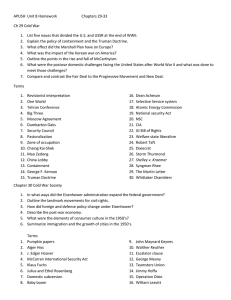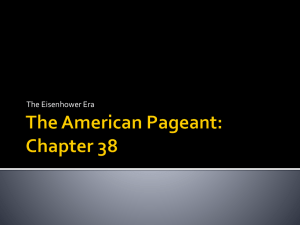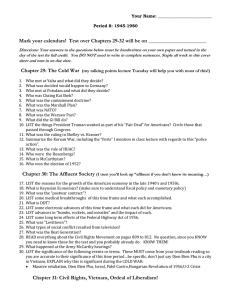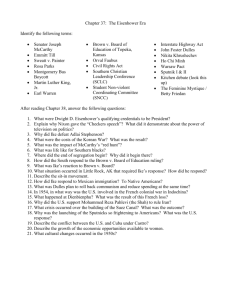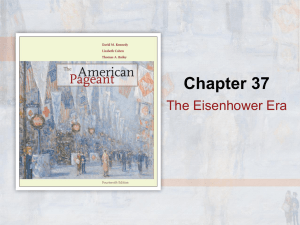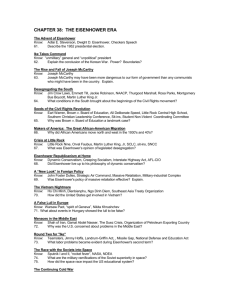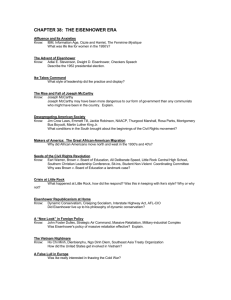Pageant Chapter 2
advertisement
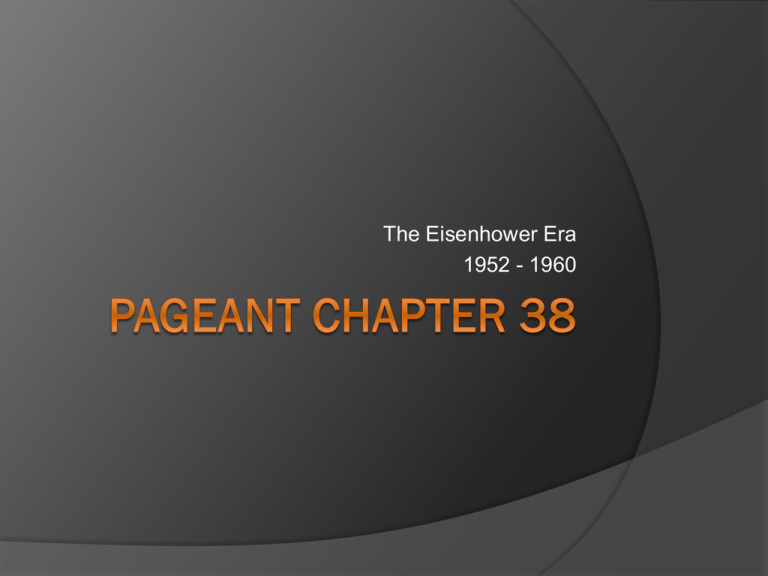
The Eisenhower Era 1952 - 1960 1. Ike, Nixon, and Korea The Election of 1952 Truman retires War-hero Dwight D. Eisenhower and his running mate Richard M. Nixon run on the Republican Party ticket They defeat Democrat Adlai Stevenson Nixon’s famous “Checkers” speech; Nixon goes on TV and uses theatrics to get the American people on the side of Eisenhower TV is now a powerful force in politics; Pros – political messages can now be sent to nearly every American household Cons – politics has now become almost like advertising and salesmanship; political messages are now tuned to the style of show biz 1. Ike, Nixon, and Korea Eisenhower’s first priority was to end the conflict in Korea Korea ended in an armistice in 1953 54,000 American soldiers lost their lives in Korea; almost as many as died in the war in Vietnam Sadly not much changed from how things were before the war; the boundary was set back at the 38th parallel President Harry S. Truman President Dwight D. Eisenhower 2. McCarthy’s “Witch-Hunt” Anti-Communist sentiments and fears were at an all time high during the 50s Wisconsin Senator Joseph McCarthy took it upon himself to root out the “reds” from American society 1954 – McCarthy appears on TV and addresses the American people on his “so-called” findings All McCarthy managed to do was ruin the reputations of many Americans and his own, as well as stir up fear He accused workers in the State Department as well as the Army He had no real basis for these charges 3. Early Civil Rights Movement 1955 – 1956 The Civil Rights movement is gaining momentum Fighting segregation, Jim Crow Laws, and the Plessy v. Ferguson Supreme Court decision The bus boycott in Montgomery, Alabama was sparked by the refusal of Rosa Parks to move to the back of the bus The boycott was led by a then unknown young minister named Martin Luther King, Jr., who would achieve national notoriety through this The NAACP, unable to get support from the legislative or executive branches of government, began pushing for change in the judicial branch The 1954 court decision Brown v. Board of Education, Topeka KS overturned separate but equal in schools set by Plessy v. Ferguson Chief Justice Earl Warren – his court would be one of the most influential in the United States The Brown decision was landmark for the civil rights movement 3. Early Civil Rights Movement 1957 King gains momentum from his success in Montgomery and forms the Southern Christian Leadership Conference This student led “sit-in” movement began in Greensboro, North Carolina This started a non-violent fire throughout the south trying to gain equal treatment restaurants, transportation, employment, housing, and voter registration This spawned the Student Non-Violent Coordinating Committee Compare contrast: SCLC – Non-violent, persistent, Christian-based, patient and peaceful SNCC – More impassioned and forceful, eventually became impatient with the quiet tactics of the SCLC; they wanted change sooner 4. Ike At Home Ike was a conservative president, but he did do some big things The Interstate Highway Act of 1956 Pro: It expanded the highway system in the United States and increased mobility. Also, the trucking, automobile, oil, and travel industries boomed. The railroad giants finally met their match There were some cons to the Highway Act Con: Air quality decreased, especially in cities. Many of the vibrant downtowns withered away while shopping malls grew in the suburbs. 5. Cold War Policy Vietnam Small southeastern country in Asia; used to be a French colony but no more 1954 – France loses a war to the Vietnamese Much to our dismay, as we were sending France aid hoping they’d win The U.S. feared that Vietnam would come under the threat of the spreading Communism in the far east (China, Russia) At a conference in Geneva, Switzerland, major powers, including the U.S., met to discuss what would happen to Vietnam U.S. wanted democracy; China wanted Communism The solution? Vietnam would be divided into Communist North Vietnam and Democratic South Vietnam at the 17th parallel It’s Korea all over again… The U.S. begins supporting the anti-communist South Vietnamese leader Ngo Dinh Diem 5. Cold War Policy Tensions mounted even more when the Soviets created a NATO of their own, called the Warsaw Pact in 1955 Matters got worse between the U.S. and the Soviet Union when in Hungary, a group of nationalists wanting liberty started an anti-communist uprising but were crushed by Soviet tanks The United States responded in the Middle East by engineering a coup (an overthrow) and installing a pro-democratic shah of Iran 5. Cold War Policy The Cold War tensions then moved into the Middle East in Egypt in 1956 Egyptian President Gamal Abdel Nasser began seeking funds to build a canal in the Nile River for irrigation and power (think Hoover Dam) Britain and France wanted to help So did the Soviets Both sides began fighting over influence in the Middle East It almost became an armed conflict BUT The U.S. refused to supply Britain and France with oil to fight the war Historically, this is known as the Suez Crisis In 1948, the U.S. was a major oil exporter, but U.S. oil is depleting rapidly The Middle East would soon become the oil giant in the world 6. Ike’s Second Term The Election of 1956 President Eisenhower runs for re-election and wins another easy victory against Democratic opponent Adlai Stevenson 1957 – The rivalry between with the U.S.S.R. amps up when Russia successfully launches the first artificial satellite, Sputnik This set off another competition to build missiles and improve technology Joseph Stalin had died in 1953 and was succeeded by Nikita Khrushchev Khrushchev causes tensions to rise when the Soviet Union begins taking sectors in the western part of Berlin However, Khrushchev pays a good-will visit to the U.S. in 1959 so things calm down But then they are amped back up when an American U-2 spy plane is caught spying on the Soviet Union 6. Ike’s Second Term Today, the United States enjoys good relations with remaining communist countries: China and Vietnam But not Cuba After protesting the 1959 Cuban Revolution led by Fidel Castro, the U.S. cut off all ties, which caused Castro to seek help from the Soviets Keep in mind that Cuba is only 90 miles south of Florida, essentially in our backyard This will come up later… 7. Transition in 1960 The 22nd Amendment was passed in 1951 Presidents are limited to two consecutive terms Eisenhower, even if he wanted to, couldn’t run for a third term He retires after two terms a popular president, American citizens saw him as a kind “grandfather” The Election of 1960 A young Massachusetts senator named John F. Kennedy is nominated by the Democrats; Kennedy is only 43 Republicans nominate the Vice-President; Richard M. Nixon This is the FIRST ELECTION where TV will play a major role 7. Transition in 1960 The contrast was fairly stark between the two candidates John Kennedy Was tanned and had a confident look; he wore make-up Wore a dark suit that really made him stick out on the screen Was coached on how to present himself on television Richard Nixon Was visibly tired from a long campaign and nursing a leg injury Refused to wear make-up; which made him look haggard His choice of a gray suit caused him to not really contrast with his surroundings (TV was black and white back then) 1st Kennedy – Nixon Debate – 1960 7. Transition in 1960 In one of U.S. history’s closest elections, Kennedy defeated Nixon by a narrow margin He was the first Catholic to be elected as a U.S. President Eisenhower passes the torch to Kennedy and in his farewell address warned the United States about a growing “military-industrial complex” So what the heck is that? 1) “Military industrial complex” – Eisenhower was basically warning America to be careful about high military spending and having a large military 2) Influence – The U.S. government must be careful NOT to be influenced by military and defense corporations that make lots of money during times of conflict In other words, if you are the owner of a gun company, and there’s peace, then you aren’t really needed; but if you can influence the government to fight a war…..then you’ll get business….get it? President John F. Kennedy Family in the 50s Electoral Map - 1960 8. Economic Trends After World War II, the American economy changed immensely Most jobs BEFORE WW2 were manufacturing jobs – blue collar After WW2, service jobs – white collar jobs – like teaching, nursing, clerks, business executives, became more numerous as the blue collar jobs declined Women’s roles had changed Immediately after WW2, they entered a “cult of domesticity”, where most women left their jobs and went back to work as the men returned As a result, the baby boom generation occurred and women were celebrated as mothers and homemakers again Leave It To Beaver – the model family in the 50s But a quiet revolution was building that would break out in the 60s When feminist Betty Friedman wrote The Feminine Mystique, women’s feelings were fueled and ready to break out of housewifery This book birthed the modern women’s movement 8. Economic Trends How has the role of women changed since the 1950s? 1) 1950s – Women were basically expected to be wives and homemakers. 2) Today – A full-time working woman has become the expected norm in the U.S. 9. The Consumer Culture Ready to enjoy life after a depression and a world war, the United States became a consumer culture in the 50s and 60s, ready to consume and enjoy all life had to offer Mass production + Advertising = A consumer culture Some examples of major consumer innovations after WW2 were: Consumer credit – It’s easy to get! Eating out – fast food - McD’s - 1955 Recreation / sports – major league baseball and professional football and basketball leagues Mass Communications – TV!!! Popular music – Rock ‘n’ Roll – Elvis – a wild new form of music Movie Stars – Marilyn Monroe - sexuality becomes more popular, more visible, and more commercialized

